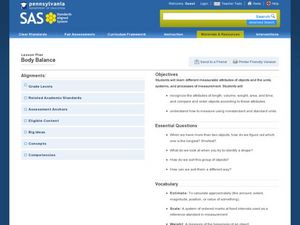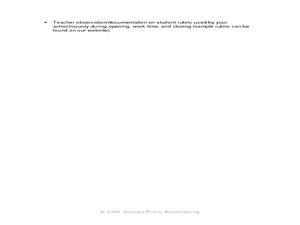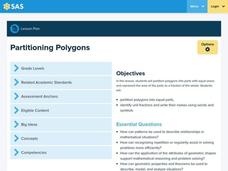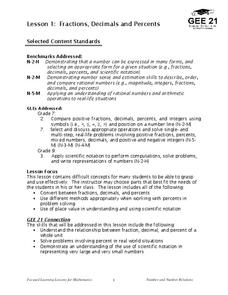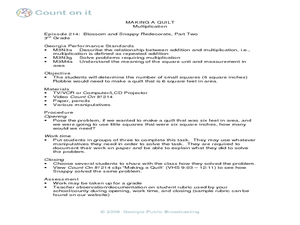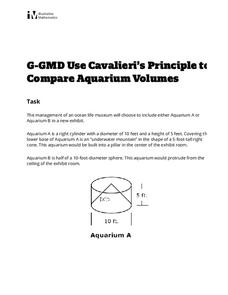Curated OER
Body Balance
Examine measurable characteristics of objects to build an understanding of the different ways you can discuss an object's size when comparing it to other objects. After whole group instruction, the class compares and organizes several...
Curated OER
How Long is a Hot Dog? Weight, Weight! Don't tell me!
Primary learners participate in activities that help them explain how different things are measured. They create their own access number chart.
Curated OER
Can You Build It?
Students investigate the concept of perimeter. They design there own figure and measure the perimeter of it. The lesson is given the context of the shape being a path that is traveled by a ladybug. This provides the shape of the plane...
Curated OER
Is Your Money Rolling Away?
Young scholars demonstrate how to solve word problems. They will watch the video "Math Can Take You Places" and identify three problem solving strategies.
Curated OER
One Size Fits All, Part 1
Can you tell how tall someone is just by looking at their feet? In this activity, young mathematicians measure their height, arm span, and foot size, graph their findings, and answer questions about how these measurements are related....
Curated OER
Twice the Rice, or More?
Students review the metric and customary systems of measurement. In groups, they experiment with rice to discover the difference between the two systems. They record their observations on a worksheet and examine how capacity differs. To...
Curated OER
Shoe Showdown
Third graders use rulers to measure their shoe size in inches and centimeters. They then enter the class shoe measurements into an excel data base and graph the results of both to make the comparison.
Curated OER
How Big Is A Humpback Whale?
Students explore humpback whales. For this humpback whale lesson, students determine the actual size of humpback whales and use diagrams to identify the major features of the humpback whale.
Curated OER
Mass, Volume, and Weight
Learners explore mass, volume, and weight. In this science and measurement lesson, students compare volume, mass, and weight after listening to the teacher's description of each. Learners explore different scales and balances and...
Curated OER
Exploring the Hudson in 1609
While this lesson focuses on a study of the Hudson River, it could be used as a template for a discussion of map skills, converting measurements, and plotting a route. The lesson includes vocabulary and other resources to make it a...
Curated OER
Generate Measurement Data Word Problems
Using a set of simple data, learners create a line plot to organize the information. This data includes only single-digit numbers and the highest number is six. Because the answer is explained and illustrated at the bottom, project this...
Curated OER
I Will Meet You In The Middle
Students use the 50 States Quarter Reversal as a context of learning a curriculum concept based from the state of Utah. They research the concepts of cause and effect. Also, they use customary units of measurement to find length and...
Curated OER
Connecting With Coordinates
Play a coordinates game to encourage collaborative learning and grid use! Learners plot points on grids and play a game that challenges them to locate a specific point on a coordinate grid by using horizontal and vertical movements.
Curated OER
The Weight of Primates
Second graders practice their problem solving skills. In this addition and subtraction skills lesson, 2nd graders solve word problems that require them to find differences and sums. This lesson features the use of a video titled "Blossom...
Curated OER
Length Addition and Subtraction Word Problems
These measurement word problems can be tricky! Scholars will need to keep track of numbers as they determine who has the shortest bed, the longer car key, and a bus longer than nine meters. For each, there is an image depicting the...
Curated OER
Polygons
Young scholars investigate the concepts related to the study of polygons. They specifically look at how angles is related. The lesson includes specific examples and dialogue to be used by the teacher during direct instruction and...
Curated OER
Fraction Strips
Get a handle on equivalent fractions through the use of manipulatives. Using area models, sets, and length manipulatives like fraction strips and Cuisenaire rods, the class will gain a deeper understanding of equivalent fractions....
Curated OER
Area of Rectangles in Word Problems
Apply area calculations to everyday situations using these three word problems. Mathematicians must pay attention to the needs of each space, determining the largest or smallest area of several options. Consider expanding on this by...
Curated OER
Fractions, Decimals and Percents
Young scholars investigate the differences when using decimals, fractions, and percents. They focus on the process of using them in real problems and how to convert them from one form to another.
Curated OER
Making a Quilt: Multiplication
Third graders explore their multiplication skills. They will use their problem solving skills to solve an everyday math problem that requires them to multiply numbers. This lesson incorporates the use a video titled "Blossom and Snappy...
Illustrative Mathematics
Use Cavalieri’s Principle to Compare Aquarium Volumes
Learners are designing a stunning new water feature for an aquarium, but they soon discover that more than just a pretty home for their fishy friends is required. From calculating the volume of a composite shape through the abstract...
Curated OER
Candy Bar Math Fun!
Students practice math. In this measurement instructional activity, students measure their favorite candy bars to the nearest inch. They work independently to compare the different lengths of the candy bars they measure.
NTTI
What Size Is It Anyway?
A fabulous plan on teaching basic concepts of measurement to young learners. Pupils use nonstandard units to measure length, practice using a ruler and a yardstick, compare the length of two objects, and perform estimations of length....
Curated OER
Just a Minute!
Students put the standard measure of clock time -- the minute -- in perspective. This lesson can be modified for virtually any grade level. They write about what they learned about a minute as a result of the activities.


